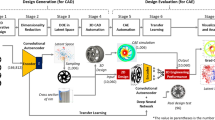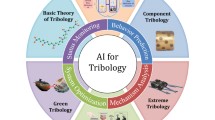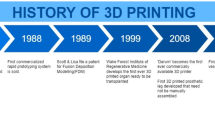Abstract
A model called TTRS for technologically and topologically related surfaces, has been developed and its application to dimensioning and tolerancing is presented here. According to this model, any part can be represented as a succession of binary surfaces associations forming a tree. Additionally, each surfaces association, termed as a TTRS object, is represented by a set of minimum geometric datum elements (MGDE). Once established, each TTRS can be given appropriate geometric dimensioning and tolerancing (GD & T) symbols through a general procedure making use of GD & T tables and combination rules. Application examples are also presented.
Similar content being viewed by others
References
A. H. Bond and S. Z. Ahmed, “Knowledge-based automatic dimensioning”, Artificial Intelligence in Engineering, Computational Mechanics Publications,4(1), pp. 32–40, 1989.
N. S. Bernstein, K. Preiss, “Representation of tolerance information in solid models”, inInternational Conference on CAD/CAM and AMT in Israël, CIRP Sessions on tolerancing for function in a CAD/CAM environment, Proceedings, vol. 2, Jerusalem, Israel. 11–14 December 1989, pp. 37–48.
A. A. G. Requicha, “Toward a theory of geometric tolerancing”,The International Journal of Robotics Research,2(4), pp. 45–60, Winter 1983.
A. A. G. Requicha and S. C. Chan, “Representation of geometric features, tolerances, and attributes in solid modelers based on constructive geometry”,IEEE Journal of Robotics and Automation,RA-2(3), pp. 156–166 September 1986.
R. Weill, “Integrating dimensioning and tolerancing in computer-aided process planning”,Robotics and Computer-Integrated Manufacturing,4(1/2), pp. 41–48, 1988.
L. E. Farmer and C. A. Gladman “Tolerance technology —Computer-based analysis”,Annals of the CIRP,35(1), pp. 7–10, 1986.
R. Jayaraman and V. Srinivasan, “Geometric tolerancing: I. Virtual boundary requirements”,IBM Journal of Research and Development,33(2), pp. 90–104, March 1989.
R. Jayaraman and V. Srinivasan, “Virtual boundary requirements and conditional tolerances in mechanical design”,IBM Research Report, RC 12942, Yorktown Heights, NY 10598, 1987.
V. Srinivasan and A. A. G. Requicha, “A proposal for the definition of size tolerancing”,ANSI Y14.5.1 Meeting, Chicago, 25–26 April 1991.
J. U. Turner, “A vector space approach to the mathematical representation of tolerances on mechanical parts”,IBM Technical Report, TR 00.3383, 13 May 1986.
J. U. Turner and M. J. Wozny, “Tolerances in computer-aided geometric design”,The Visual Computer, Springer, vol. 3, 1987, pp. 214–226.
A. Wirtz, “Vectorial tolerancing for production quality control and functional analysis in design”,CIRP International Working Seminar on Computer-Aided Tolerancing, Penn State University, 16–17 May 1991, pp. 77–84.
“Technique de mesure en coordonnées; Principes géométriques fondamentaux et définitions”, Norme provisoire 257 800, Norme enregistrée de l'Association Suisse de Normalisation, Société Suisse des Constructeurs de Machines, 1988.
F. Kimura and H. Suzuki, “Treatment of tolerances in product modeling environment”,International Conference on CAD/CAM and AMT in Israel, CIRP Conference, Jerusalem, Israel, 11–14 December 1989.
S. A. Irani, R. O. Mittal and E. A. Lehtihet, “Tolerance chart optimization”,International Journal of Production Resarch,27(9), pp. 1531–1552, 1989.
P. H. Gu and H. A. Eimaraghy, “Expert tolerancing consultant for goemetric modelling”,Proceedings of Manufacturing International '88, Symposium on Product and Process Design, ASME, vol. 1, April 1988, pp. 17–22.
B. Charles, A. Clément, A. Desrochers, P. Pelissou and A. Rivière, “Controlling a mechanical part designed with a feature based system”,Computer Integrated Quality System in CIM, IFIP T.C.5/W.G.5.3. Working Conference, Belgrade, Yugoslavia, 20–23 June 1989, pp. 201–214.
B. Charles, A. Clément, A. Desrochers, P. Pelissou and A. Rivière, “Toward a computer aided functional tolerancing model”,International Conference on CAD/CAM and AMT in Israel, CIRP Sessions on tolerancing for function in a CAD/CAM environment, Proceedings, vol. 2, Jerusalem, Israel, 11–14 December 1989, section C-2-4, pp. 1–7.
A. Clément, A Desrochers and A. Rivière, “Theory and practice of 3-D tolerancing for assembly”,CIRP International Working Seminar on Computer-Aided Tolerancing, Penn State University, 16–17 May 1991, pp. 25–55.
Author information
Authors and Affiliations
Rights and permissions
About this article
Cite this article
Desrochers, A., Clément, A. A dimensioning and tolerancing assistance model for CAD/CAM systems. Int J Adv Manuf Technol 9, 352–361 (1994). https://doi.org/10.1007/BF01748479
Issue Date:
DOI: https://doi.org/10.1007/BF01748479




